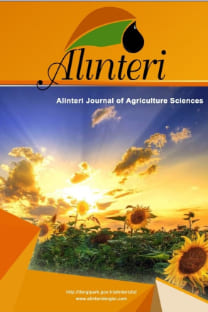Extraction of Chitin from Crayfish (Astacus leptodactylus) Shell Waste
In this study, chitin was chemically extracted from the crayfish (Astacus leptodactylus) shells. Deproteinization, demineralization and decolorization processes were applied to obtain chitin. In order to determine characterization of the chitosan; yield, moisture and ash contents, degree of deacetylation, colour properties, Fourier Transform Infrared Spectroscopy (FTIR) and Scanning Electron Microscopy (SEM) analyses were applied. The deacetylation degree of chitin from crayfish shells was found as 25.67% detected by elemental analysis. L*, a*, b*, chroma, hue and whiteness in color properties of crayfish chitin were measured. The chemical composition of crayfish chitin was characterized with FTIR analysis. SEM analysis of shells and chitin samples were obtained and compared at different magnification. The findings of the present study are important to obtain the chitin from unevaluated crayfish wastes.
___
Abdou, E.S., Nagy, K.S.A. and Elsabee, M.Z., 2008. Extraction and characterization of chitin and chitosan from local sources. Bioresource Technology, 99:1359-1367.Deshpande, M.V., 1986. Enzymatic degradation of chitin and its biological applications. Journal of Scientific & Industrial Research, 45:273-281.
Erol, G., Özkök, R., Küçükkara, R., Çınar, Ş., 2010. Tatlı Su İstakozu Astacus leptodactylus (Eschscholtz, 1823) Yetiştiriciliğinde Yavru Dönemde Muhtemel Ölüm Nedenleri. Süleyman Demirel Üniversitesi Eğirdir Su Ürünleri Fakültesi Dergisi, 6(2): 23-30.
Fernandez-Kim, S.O., 2004. Physicochemical and Functional Properties of Crawfish Chitosan as Affected By Different Processing Protocols. Master Thesis. Louisiana State University and Agricultural and Mechanical College.
Ghannam, H.E., Stalab, A., Dolgano, N.V., Husse, A. and Abdelmagui, N.M., 2016. Characterization of Chitosan Extracted from Different Crustacean Shell Wastes. Journal of Applied Sciences 16:454-461.
Harlıoğlu, M.M., 2004. The present situation of freshwater crayfish, Astacus leptodactylus (Eschscholtz, 1823) in Turkey. Aquaculture, 230: 181–187.
Hunner, J.V., 1994. Freshwater Crayfish Aquaculture in North America, Europe, and Australia Families Astacidae, Cambaridae, and Parastacidae. Food Products Press, An Imprint of the Haworth Press, Inc. New York, London.
Küçükgülmez, A., Celik, M., Yanar, Y., Şen, D., Polat, H. and Kadak, A.E., 2011. Physicochemical characterization of chitosan extracted from Metapenaeus stebbingi shells. Food Chemistry, 126:1144–1148.
No, H.K., Meyers, S.P. and Lee, K.S., 1989. Isolation and Characterization of Chitin from Crawfish Shell Waste. Journal of Agricultural and Food Chemistry, 37(3):575-579.
Rabea, E.I., Badawy, M.E.T., Stevens, C.V., Smagghe, G. and Steurbaut, W., 2003. Chitosan as antimicrobial agent: applications and mode of action. Biomacromolecules, 4(6): 1457–1465.
Rout, S.K., 2001. Pyhsicochemical, functional, and spectroscopic analysis of crawfish chitin and chitosan as affected by process modification. M.S. in E.S., Louisiana State University.
Seo, S., King, J. M. and Prinyawiwatkul, W. 2007. Simultaneous depolymerisation and decolorization of chitosan by ozone treatment. Journal of Food Science, 72(9), 522–526.
Shiau, S.Y. and Yu, Y.P. (1999). Dietary supplementation of chitin and chitosan depresses growth in tilapia, Oreochromis niloticus O. aureus. Aquaculture, 179:439–446.
Tan, S. C., Tan, T. K., Wong, S. M. and Khor, E., 1996. The chitosan yield of zygomycetes at their optimum harvesting time. Carbohydrate Polymers, 30(4): 239–242.
Yen, M.T., Yang, J.H. and Mau, J.L., 2009. Physicochemical characterization of chitin and chitosan from crab shells. Carbohydrate Polymers, 75:15-21.
- ISSN: 2564-7814
- Yayın Aralığı: 2
- Başlangıç: 2007
- Yayıncı: Adem Yavuz SÖNMEZ
